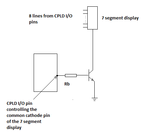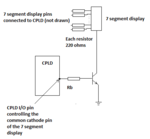garvind25
Full Member level 3

Hi,
I wanted to interface a common cathode 7 segment display unit with a CPLD (XC2C128). To control if the 7 segment unit is enabled, I am planning to interface the common cathode pin through an npn transistor (as shown in the attachment). When the corresponding CPLD pin will be high, the transistor will be switched on with 3.3 v base voltage and vice versa. How do I select the value of Rb pls. I am fixing the current through each segment of the display to be 6 mA. So in the minimum case when only on segment is switched on, collector current will be 6 mA and Rb is coming out to be 43.33Kohm (assuming Hfe=100). In the maximum case, when the current will be 6X8=48 mA, the Rb is coming out to be 5.42 Kohms. So which value of resistor should I choose for transistor base resistance. I will be using 3.3v I/O standards (ie. logic 1 is 3.3v).
Thanks,
Arvind Gupta

I wanted to interface a common cathode 7 segment display unit with a CPLD (XC2C128). To control if the 7 segment unit is enabled, I am planning to interface the common cathode pin through an npn transistor (as shown in the attachment). When the corresponding CPLD pin will be high, the transistor will be switched on with 3.3 v base voltage and vice versa. How do I select the value of Rb pls. I am fixing the current through each segment of the display to be 6 mA. So in the minimum case when only on segment is switched on, collector current will be 6 mA and Rb is coming out to be 43.33Kohm (assuming Hfe=100). In the maximum case, when the current will be 6X8=48 mA, the Rb is coming out to be 5.42 Kohms. So which value of resistor should I choose for transistor base resistance. I will be using 3.3v I/O standards (ie. logic 1 is 3.3v).
Thanks,
Arvind Gupta



